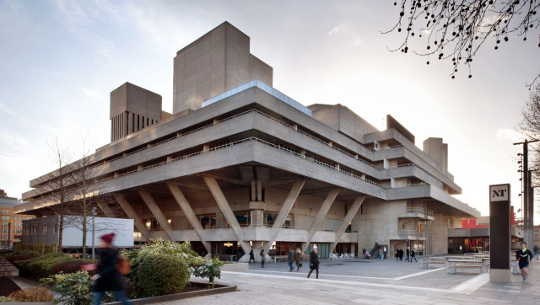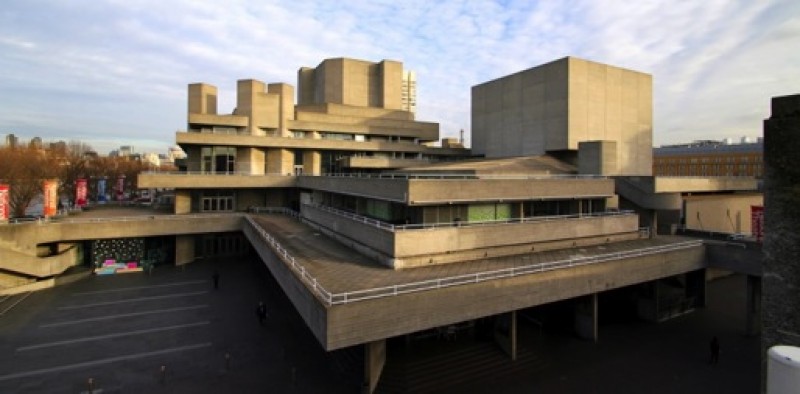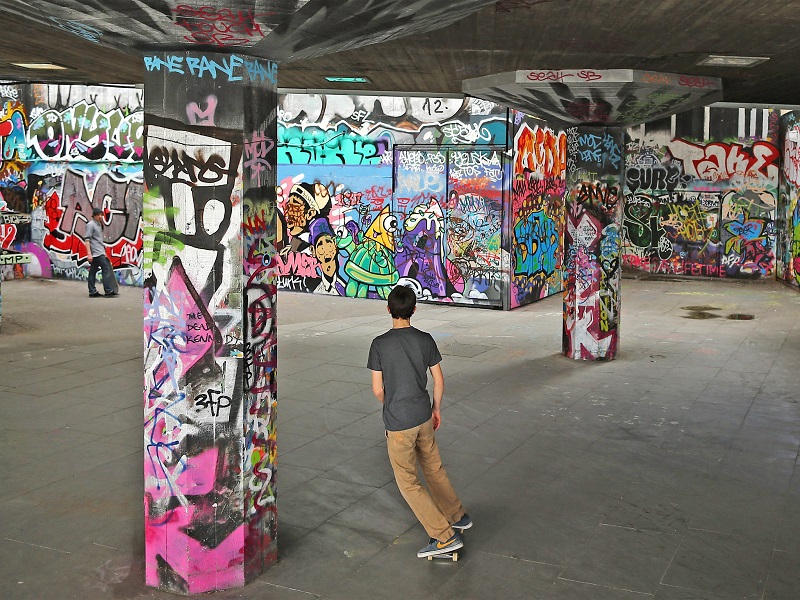National Theatre
Designed by Denys Lasdun and completed in 1976, the National Theatre is one of London's best-known Brutalist buildings. It is also one of the most divisive, described by Prince Charles as like "a nuclear power station".
Standing on the South Bank of the Thames, the concrete building is formed by two fly towers rising from layered horizontal terraces cascading to river level. The design was based on Lasdun's ideas for 'architecture as urban landscape.'
The vast structure accommodates three theatres, the largest of which is capable of seating 1,160 people, as well as restaurants, bars, foyers, workshops and so on.
Lasdun was appointed as architect on the project in 1963, and although he had no prior experience in theatre design, he persuaded the board of directors and others to let him realise his singular vision.
He described the early design process as being evolutionary in nature, shaped through consultations. His intention was for the strata of the building – with interconnected walkways, split levels and circular stairwells - to merge with the South Bank, making it unclear where the theatre begins and ends.
The construction work was carried out by Sir Robert McAlpine. The rough-cast concrete surface of the theatre’s interior and exterior retains the imprints of the timber planks used as formwork. Lasdun said; "Concrete is a very intractable material, but it can be a beautiful material if it is used in the way its own nature intends it to be used... It is a sort of sculpture that you can only do with reinforced concrete, but you need to work to a certain scale... It is not a cosy little material."
In 1994, just 18 years after the building was completed and opened to the public,it was granted Grade II listing status. Despite this, it has remained a divisive addition to London’s architecture, being revered and derided in equal measure.
However, some opinions have evolved with time. Most notably, with regard to the skateboarders who adopted the terraces and undercrofts as a graffiti-strewn skate park. Often cited as evidence of the theatre’s failed architecture, in 2014-15 it was saved from redevelopment after a successful and high-profile campaign promoted it as being ‘one of the great spaces of London.
[edit] Find out more
[edit] Related articles on Designing Buildings Wiki
Featured articles and news
Key points for construction at a glance with industry reactions.
Functionality, visibility and sustainability
The simpler approach to specification.
Architects, architecture, buildings, and inspiration in film
The close ties between makers and the movies, with our long list of suggested viewing.
SELECT three-point plan for action issued to MSPs
Call for Scottish regulation, green skills and recognition of electrotechnical industry as part of a manifesto for Scottish Parliamentary elections.
UCEM becomes the University of the Built Environment
Major milestone in its 106-year history, follows recent merger with London School of Architecture (LSE).
Professional practical experience for Architects in training
The long process to transform the nature of education and professional practical experience in the Architecture profession following recent reports.
A people-first approach to retrofit
Moving away from the destructive paradigm of fabric-first.
International Electrician Day, 10 June 2025
Celebrating the role of electrical engineers from André-Marie Amperè, today and for the future.
New guide for clients launched at Houses of Parliament
'There has never been a more important time for clients to step up and ...ask the right questions'
The impact of recycled slate tiles
Innovation across the decades.
EPC changes for existing buildings
Changes and their context as the new RdSAP methodology comes into use from 15 June.
Skills England publishes Sector skills needs assessments
Priority areas relating to the built environment highlighted and described in brief.
BSRIA HVAC Market Watch - May 2025 Edition
Heat Pump Market Outlook: Policy, Performance & Refrigerant Trends for 2025–2028.
Committing to EDI in construction with CIOB
Built Environment professional bodies deepen commitment to EDI with two new signatories: CIAT and CICES.
Government Grenfell progress report at a glance
Line by line recomendation overview, with links to more details.
An engaging and lively review of his professional life.
Sustainable heating for listed buildings
A problem that needs to be approached intelligently.
50th Golden anniversary ECA Edmundson apprentice award
Deadline for entries has been extended to Friday 27 June, so don't miss out!
CIAT at the London Festival of Architecture
Designing for Everyone: Breaking Barriers in Inclusive Architecture.
Mixed reactions to apprenticeship and skills reform 2025
A 'welcome shift' for some and a 'backwards step' for others.





























